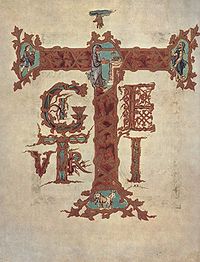
Drogo Sacramentary
Encyclopedia


Carolingian
The Carolingian dynasty was a Frankish noble family with origins in the Arnulfing and Pippinid clans of the 7th century AD. The name "Carolingian", Medieval Latin karolingi, an altered form of an unattested Old High German *karling, kerling The Carolingian dynasty (known variously as the...
illuminated manuscript
Illuminated manuscript
An illuminated manuscript is a manuscript in which the text is supplemented by the addition of decoration, such as decorated initials, borders and miniature illustrations...
on vellum
Vellum
Vellum is mammal skin prepared for writing or printing on, to produce single pages, scrolls, codices or books. It is generally smooth and durable, although there are great variations depending on preparation, the quality of the skin and the type of animal used...
of c.850
850
Year 850 was a common year starting on Wednesday of the Julian calendar.- Asia :* Emperor Montoku succeeds Emperor Nimmyō as Emperor of Japan.- Europe :...
AD, one of the monuments of Carolingian book illumination
Carolingian art
Carolingian art comes from the Frankish Empire in the period of roughly 120 years from about AD 780 to 900 — during the reign of Charlemagne and his immediate heirs — popularly known as the Carolingian Renaissance. The art was produced by and for the court circle and a group of...
. A sacramentary
Sacramentary
The Sacramentary is a book of the Middle Ages containing the words spoken by the priest celebrating a Mass and other liturgies of the Church. The books were usually in fact written for bishops or other higher clegy such as abbots, and many lavishly decorated illuminated manuscript sacramentaries...
is a book containing all the prayers spoken by the officiating priest during the course of the year.
The Sacramentary was written and painted for the personal use of Charlemagne
Charlemagne
Charlemagne was King of the Franks from 768 and Emperor of the Romans from 800 to his death in 814. He expanded the Frankish kingdom into an empire that incorporated much of Western and Central Europe. During his reign, he conquered Italy and was crowned by Pope Leo III on 25 December 800...
's son Drogo
Drogo of Metz
Drogo , also known as Dreux or Drogon, was an illegitimate son of Frankish emperor Charlemagne by the concubine Regina....
, bishop of Metz. Metz was an important bishopric: Charles the Bald
Charles the Bald
Charles the Bald , Holy Roman Emperor and King of West Francia , was the youngest son of the Emperor Louis the Pious by his second wife Judith.-Struggle against his brothers:He was born on 13 June 823 in Frankfurt, when his elder...
was crowned in the Basilica, and there Louis the Pious
Louis the Pious
Louis the Pious , also called the Fair, and the Debonaire, was the King of Aquitaine from 781. He was also King of the Franks and co-Emperor with his father, Charlemagne, from 813...
and his illegitimate half-brother Drogo the Bishop are buried. In 843 Metz became the capital of the kingdom of Lotharingia
Lotharingia
Lotharingia was a region in northwest Europe, comprising the Low Countries, the western Rhineland, the lands today on the border between France and Germany, and what is now western Switzerland. It was born of the tripartite division in 855, of the kingdom of Middle Francia, itself formed of the...
, and several diets and councils were held there.
Drogo's position enabled him to be one of the great patrons of 9th-century arts. He embellished his cathedral in Metz with works which rank among the highlights of Carolingian art in beauty and preciousness. Among them are three surviving manuscripts from the court school, of which the Drogo Sacramentary is the most mature and most accomplished.
This Sacramentary is not the product of a monastic scriptorium
Scriptorium
Scriptorium, literally "a place for writing", is commonly used to refer to a room in medieval European monasteries devoted to the copying of manuscripts by monastic scribes...
but reveals an origin in a court school. It contains only those liturgical sections that the bishop spoke. An example of the individual character of its iconography is the initial O for Palm Sunday
Palm Sunday
Palm Sunday is a Christian moveable feast that falls on the Sunday before Easter. The feast commemorates Jesus' triumphal entry into Jerusalem, an event mentioned in all four Canonical Gospels. ....
prayers, which contains a Crucifixion of a new iconographic type, one that would be called christus patiens rather than the triumphant Christ on the cross (christus triumphans) that had been the norm. In the image, the dead and tortured body of Christ spouts water and blood, which are collected by a female figure recognizable as Ecclesia, the Church, in a chalice, that would become entangled with the Holy Grail
Holy Grail
The Holy Grail is a sacred object figuring in literature and certain Christian traditions, most often identified with the dish, plate, or cup used by Jesus at the Last Supper and said to possess miraculous powers...
legend in the future. The Serpent
Serpent (Bible)
Serpent is the term used to translate a variety of words in the Hebrew bible, the most common being , , the generic word for "snake"....
entwines the base of the cross and figures representing the Sun and Moon witness the event from above. The manuscript's style, too, is considered to show the patron's influence, in an unusually unified work of a small group of artists working in close cooperation.
It is 264 mm by 214 mm and has 130 folios. It is lavishly illuminated.

